HL Biology Unit 8.1-8.2 Cell Respiration
1/57
Earn XP
Description and Tags
Name | Mastery | Learn | Test | Matching | Spaced |
|---|
No study sessions yet.
58 Terms
Metabolism
All chemical reactions (catabolic+anabolic) that occur in a living organism
Cytosol
The portion of the cytoplasm that is NOT contained WITHIN membrane-bound organelles
Metabolic Pathways
Linked series of chemical reactions occurring within a cell that are enzyme-mediated, often with diff. enzymes needed for each stage
What is the difference between linear and cyclical metabolic pathways?
Linear: Final product moves on to serve a different purpose
Cyclical: Final product feeds the initial reaction (ex. Urea cycle, where ornithine is re-used)
What are properties (4) of Enzymes?
Globular Proteins
Increases reaction rate by decreasing activation energy
Undergo conformational change to create induced fit for substrates
Shape determines substrate specificity - which substrate it binds to
Enzyme Inhibitors
Molecules that block enzyme function either competitively or non-competitively
What is the difference between competitive and non-competitive enzyme inhibitors? Visualize their effects on a graph.
Competitive: Allow reactions via enzymes to reach their maximum rate of reaction (just slower) because substrates will eventually reach enzymes before inhibition happens
Non-competitive: Do NOT allow reactions to reach maximum rate because a certain amount of total enzymes available will be “poisoned”, not allowing for the substrate to bind with them bc of active site shape deformation regardless of how much substrate is available
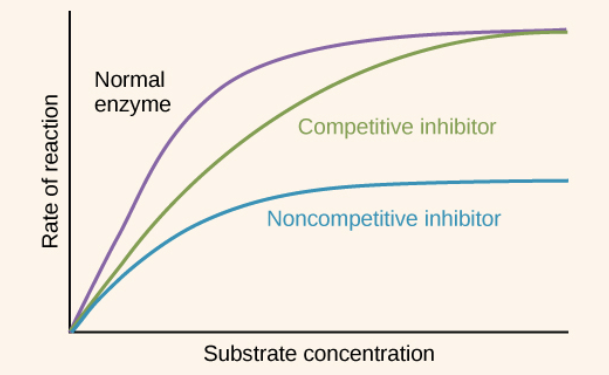
What is an example of temporary compettive inhibition?
Statins are a group of medicines used to lower low-density lipoproteins (LDL)/ “bad” cholesterol production in the liver by temporarily binding to the active site of HMG-CoA Reductase
What is an example of permanent competitive inhibition?
Penicillin irreversibly binds to the transpeptidase active site, which prevents bacterial cell walls from being built, effectively killing any unwanted bacteria.
What is end-product inhibition?
a type of enzyme inhibition used to regulate metabolic pathways, where the final product regulates the first reaction to prevent overproduction
What is an example of end-product inhibition?
Isoleucine functions as an end-product inhibitor, creating a self-regulated pathway. If there is a sufficient/low concentration of isoleucine, the active site from the 1st enzyme is free, and if there is a high concentration, the accumulated isoleucine binds to the 1st enzyme to prevent further production
(also, threonine is the initial substrate that turns into isoleucine).
What is ATP?
Adenosine triphosphate is a nucleotide that is used for energy storage/transfer of energy between processes and parts of the cell
What are characteristics (5) of ATP that make it suitable for its function?
Water soluble, so it can move freely through the cytoplasm to reach different organelles
Stable at neutral pHs, which matches the cytoplasm
Its movement can be controlled because as a large, negatively charged particle, it can’t pass through the phospholipid bilayer
The 3rd phosphate group can be easily removed by hydrolysis to create ADP
The transformation of ATP → ADP creates just enough energy for cell processes but not enough so that it would be wasted as heat
What processes is ATP used for?
Synthesizing Macromolecules, Active Transport, Movement
What is an example of ATP being used to synthesize macromolecules?
Anabolic reactions are endothermic and therefore required energy - 1 or more ATP molecules are used each time a monomer is linked ex. DNA (replication), RNA (transcription), Proteins (translation)
What is an example of ATP being used in active transport?
Pumping ions across the concentration gradient requires energy: ATP changes pumps from their stable state to their less stable state (but ATP is not required for the pumps to revert back into their stable state
What is an example(s) of ATP being used for movement in/of the cell? Which type of movement requires more energy?
Chromosomes moving to opposite poles during mitosis (anaphase)
Cells pinching apart during mitosis
Vesicles moving to transport materials
Phagocytes using locomotion; changing their shape to move to sites of infection
Muscle cell contractions occur when large arrays of myosin and actin filaments slide on top of e/o
Movements require changes in shape require the most energy.
What is the conversion of ATP → ADP for? What’s a downside and an IRL example that overcomes it?
This conversion releases energy to be used by the cell, but this process is not 100% efficient bc some is lost as heat, and there’s only a little bit of ATP in our bodies at a time (0.2 mol).
The six-eyed spider can remain motionless to conserve ATP
What is cell respiration?
Energy released by oxidizing carbs/fats/proteins
What happens when we use up all of our ATP?
Neurons can’t convey impulses
Muscles stop contracting, leading to cramps
Cells degrade irreparably in minutes
How is ATP and ADP regenerated?
ATP = cell respiration
ADP = active cell processes
What are respiratory substrates?
Compounds that are oxidized during cell respiration to create ATP
What kinds of respiratory substrates are used for plants and humans?
Humans = food (glucose, fatty acids)
Plants = carbs or lipids from photosynthesis
What is the relationship between gas exchange and cell respiration?
They’re both independent processes that work through simple diffusion.
Gas exchange ensures O and CO2 balance
Simple diffusion of gases is only possible because of the concentration gradient created by cell respiration
Differences in types of cell respiration:
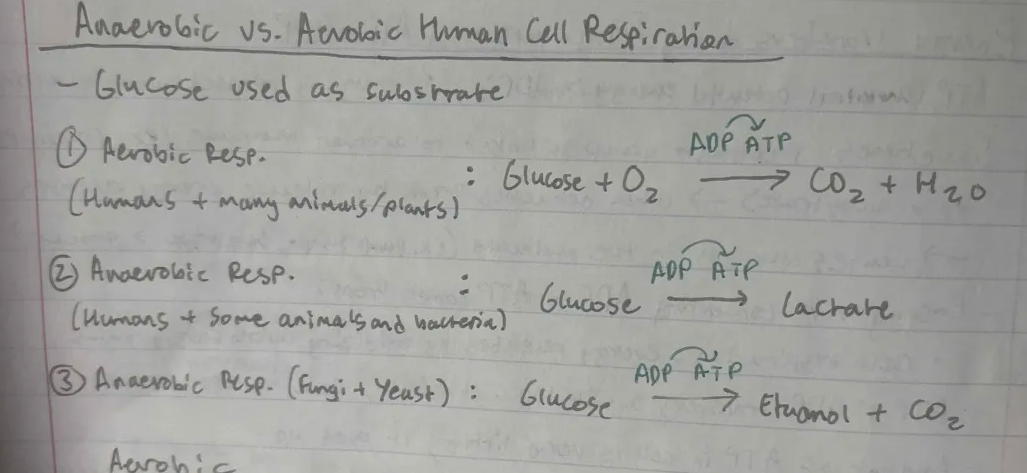
Differences (5) between anaerobic and aerobic respiration
Aerobic
Oxygen used as electron acceptor
Uses carbs like glucose, lipids like fats/oils, and amino acids after deamination
Waste: CO2+H2O
High ATP Yield (30+ molecules/glucose)
Starts in cytoplasm, also occurs in mitochondria
Anaerobic
No oxygen used
Only carbs used
Waste: CO2 + Lactate or Ethanol
Lower ATP yield (2 molecules/glucose)
Reactions only in cytoplasm
Describe respiration in muscles
Aerobic normally, anaerobic in spurts for max power
Lactic acid waste buildup from anaerobic resp. needs to be broken down, which uses O2 → overuse causes oxygen debt, which is why we run out of breath
How can rate of respiration be measured?
O2 uptake
CO2 production
Amount of glucose/other respiratory substrates consumed
What are electron carriers?
Substances that can accept/lose electrons reversibly, often linking oxidation + reduction (ex. NAD, nicotinamide adenine dinucleotide)
Explain the two ways that NAD can act as an electron carrier
By Losing H+ Atoms
NAD + 2H+ + 2e- → NADH+ (reduced NAD) + H+
Each H contains 1p and 1e, NAD accepts 2e and one H+ so the other H+ is released
By Gaining O Atoms
Nitrifying Bacteria: NO2- + (1/2)O2 → NO3-
What is Glycolysis?
The 1st step of AEROBIC respiration (and technically before anaerobic respiration) in the cytoplasm that converts glucose/other monosaccharide substrates into pyruvate, producing a small ATP yield (w/o oxygen, but later steps need it).
What is phosphorylation?
The addition of phosphate (PO43-) to a molecule
Describe the 1st step of Glycolysis
Phosphorylation of Glucose
Usually occurs through ATP transferring a phosphate group to glucose
Requires energy to make molecules more unstable, and therefore more likely to participate in later reactions
Glucose→ (ATP→ADP) Glucose-6-phosphate
Glucose-6-phosphate → Fructose-6-phosphate
Fructose-6-phosphate → (ATP→ADP) Fructose-1, 6-bisphosphate
Describe the 2nd step of Glycolysis
Lysis
Fructose-1, 6-bisphosphate → 2 triose phosphate
Describe the 3rd step of Glycolysis
Oxidation
Oxidation of sugar to produce organic acid
Triose phosphate + phosphate → (NAD → NADH) bisphosphoglycerate
Describe the 4th step of Glycolysis
ATP Formation
bisphosphoglycerate →→ (ADP→ATP) (ADP→ATP) pyruvate
(the BI part allows two molecules of pyruvate, so this yields 2 ATP. There are 2 bisphosphoglycerates made per glucose, so the total yield in this stage is 4 ATP)
What is the final yield after the 4 stages of glycolysis?
1 glucose (6 carbon) is converted to 2 pyruvates (3 carbons each)
2 NAD → 2 NADH
2 ATP used (stage 1) + 4 ATP produced (stage 4) = 2 ATP net yield
What is the Link Reaction?
The reaction that links glycolysis to the krebs cycle by turning pyruvate (the product of glycolysis) into Acetyl-CoA (the first reactant in the krebs cycle)
What is the Krebs Cycle?
The oxidation of Acetyl-CoA in the mitochondria matrix to produce a small amount of ATP and electron carriers (NADH and FADH2) required to facilitate the electron transport chain, which makes most of the ATP in aerobic respiration.
How do the number of carbons change throughout the Krebs Cycle?
Pyruvic Acid (3C)
1st decarboxylation forms Acetyl-CoA (2C)
Citrate (6C)
2nd decarboxylation (5C)
3rd decarboxylation (4C)
Final product, oxaloacetate (4C)
What are the final products of the Link Reaction + the Krebs cycle?
Per 1 glucose (2 pyruvate) made in glycolysis:
8NADH
2 FADH2
2 ATP (will be used)
6 CO2 (waste)
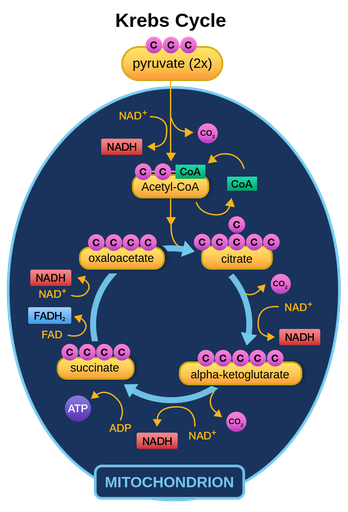
What is Oxidative Phosphorylation?
A process occurring in the intermembrane space of the mitochondria used to form ATP using electron carriers (protein pumps) energized by electrons from other electron carriers (NADH, FADH2).
This process is divided into the Electron Transport Chain and Chemiosmosis
What is the Electron Transport Chain?
A chain of proteins that transfer electrons to create a chemical gradient between the intermembrane space and matrix of the mitochondria, used to help ATP synthase activity in oxidative phosphorylation
What is the final electron acceptor in the Electron Transport Chain? What is produced after?
O2 accepts the last H+ ion (electron) to form H2O as waste
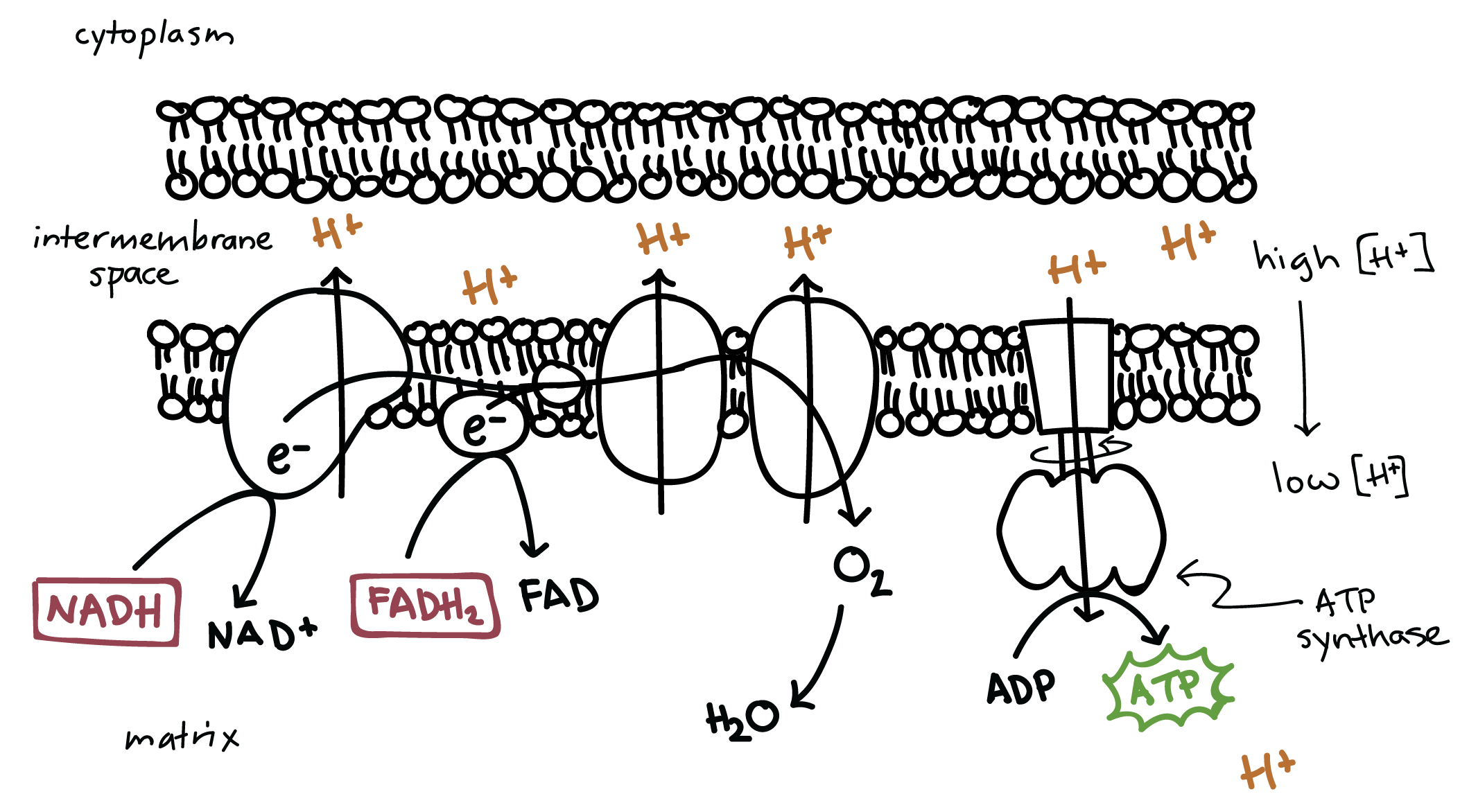
What is ATP Synthase?
An enzyme that uses the concentration gradient of ions created by the ETC as kinetic energy to combine ADP + Pi (phosphate) → ATP in a process called chemiosmosis
What is chemiosmosis?
The passive transport of protons in the intermembrane space down the concentration gradient back into the mitochondrial matrix
What other material can be oxidized the same way as pyruvate in the link reaction to start the Krebs Cycle?
Fatty acids
What are the characteristics of using fats as a source of energy for cell respiration?
Aerobic only
Each 2 carbon fragment in a fatty acid can be used to make 1 Acetyl-CoA
Why do fatty acids offer more energy than carbs?
They contain more carbon to make Acetyl-CoA than glucose
Triglycerides are less oxidized, so they have more C-C and C-H bonds and therefore more potential oxidation reactions that could provide energy
Compare and Contrast the use of carbs and fatty acids as energy for cell respiration
Carbs
Anaerobic or aerobic process
Occurs in glycolysis
Fatty Acids
Aerobic only
More carbon → More Acetyl-CoA per gram
More reduced → more oxidation → greater energy release
Both
Both undergo oxidation to release energy
Can be used to make Acetyl-CoA
Label the parts of the mitochondria
A. Intermembrane space
B. Outer membrane
C. Cristae (folds of inner membrane)/Inner Membrane
D. Matrix
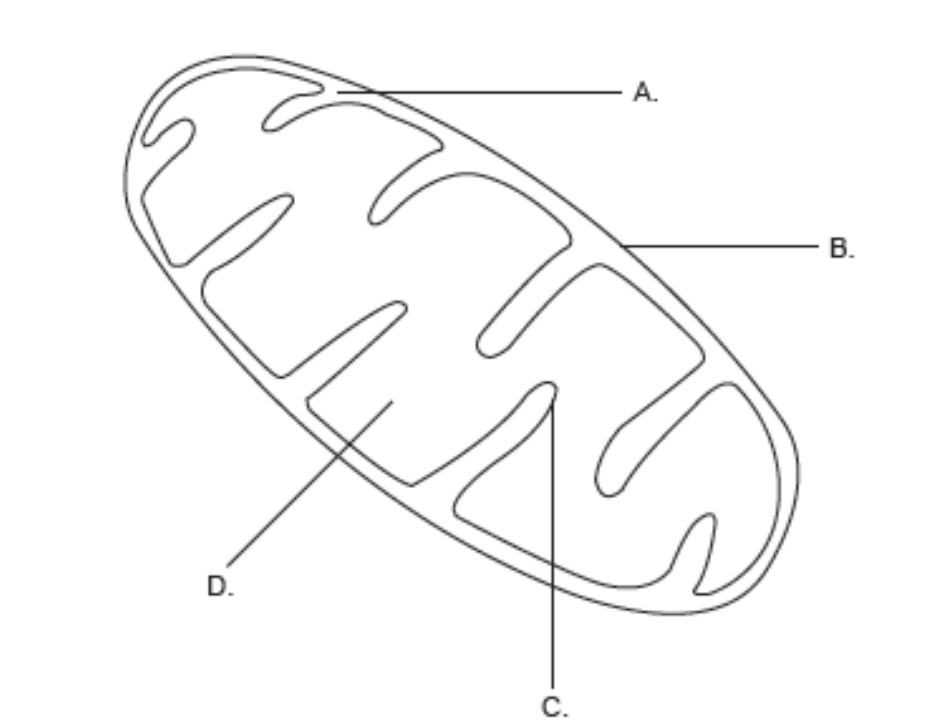
How is NAD regenerated anaerobically?
Lactic Acid Fermentation
2 NAD used in glycolysis to form 2NADH
2NADH used to convert pyruvate into lactate/ethanol, so 2 NAD regained
Pyruvate → (NADH→NAD+) Lactate
Pyruvate → (NADH→NAD+) Ethanol
What is the purpose of anaerobic respiration?
To produce a small yield of ATP and to regenerate NAD
Why, theoretically, can NAD be regenerated indefinitely? Why could this not be true?
Glycolysis uses 2NAD (to make NADH) and fermentation replaces it with 2NAD (by oxidizing NADH), so NAD can be recycled indefinitely. This occurs unless:
There aren’t stores for glucose
All ADP is converted into ATP (glycolysis wouldn’t have to occur if this was the case)
There is a dangerously high concentration of lactate produced
Compare lactic acid and alcohol fermentation
Anaerobic
Occur in Cytoplasm
Small ATP Yield
Starts with glycolysis to make pyruvate, which is then used for their processes
What is the 1st step of anaerobic respiration in yeast?
CO2 is removed from pyruvate by decarboxylation → ethanal
What is the 2nd step of anaerobic respiration in yeast?
2H is transferred from NAD to ethanal → ethanol
Both steps together: pyruvate → (CO2 waste) ethanal → (NADH→NAD) ethanol
What is a facultative anaerobe and an example?
An anaerobic organism that uses both aerobic respiration or fermentation (anaerobic) depending on presence of oxygen